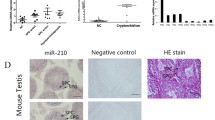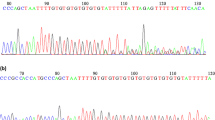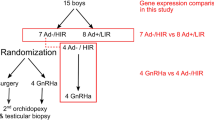Abstract
The most frequent defect of the male urogenital tract at birth is cryptorchidism. Cryptorchidism causes primitive testicular pathology responsible for infertility. Men with Down’s syndrome (DS) have an increased risk of cryptorchidism. The spermatid perinuclear RNA-binding protein (STRBP) gene codifies a microtubule-associated RNA-binding protein and it is highly expressed in the testis as well as in the brain. At both levels, this gene seems to play a relevant role in the regular development of these organs. These observations prompted us to evaluate the expression of STRBP mRNA in 5 DS men with cryptorchidism and 5 normal healthy men (controls) by quantitative Real Time PCR in peripheral blood leukocytes. We found a decreased expression of the STRBP gene in men with DS and cryptorchidism compared with controls. This finding suggests that the impaired expression of this gene in DS may play a pathogenetic role in the altered brain and testicular development in subjects with DS and cryptorchidism.
Similar content being viewed by others
References
Fonkalsrud EW. Current concepts in the management of the undescended testis. Surg Clin North Am 1970, 50: 847–52.
Liu Y, Li X. Molecular basis of cryptorchidism-induced infertility. Sci China Life Sci 2010, 53: 1274–83.
Hutson JM, Balic A, Nation T, Southwell B. Cryptorchidism. Semin Pediatr Surg 2010, 19: 215–24.
La Vignera S, Calogero AE, Condorelli R, et al. Cryptorchidism and its long-term complications. Eur Rev Med Pharmacol Sci 2009, 13: 351–6.
Chew G, Hutson JM. Incidence of cryptorchidism and ascending testes in trisomy 21: a 10 year retrospective review. Pediatr Surg Int 2004, 20: 744–7.
Schumacher JM, Lee K, Edelhoff S, Braun RE. Spnr, a murine RNA-binding protein that is localized to cytoplasmic microtubules. J Cell Biol 1995, 129: 1023–32.
Schumacher JM, Artzt K, Braun RE. Spermatid perinuclear ribonucleic acid-binding protein binds microtubules in vitro and associates with abnormal manchettes in vivo in mice. Biol Reprod 1998, 59: 69–76.
Pires-daSilva A, Nayernia K, Engel W, et al. Mice deficient for spermatid perinuclear RNA-binding protein show neurologic, spermatogenic, and sperm morphological abnormalities. Dev Biol 2001, 233: 319–28.
Salemi M, Calogero AE, Bosco P, et al. Expression of SpanX mRNA in testicular germ cell tumours. Hum Cell 2006, 19: 87–90.
Livak KJ, Schmittgen TD. Analysis of relative gene expression data using real-time quantitative PCR and the 2(-Delta Delta C(T)) Method. Methods 2001, 4: 402–8.
Salemi M, Castiglione R, La Vignera S, et al. Over expression of LDOC1 and PARP1, two pro-apoptotic genes, in a patient with cryptorchidism and DiGeorge anomaly. Hum Cell 2011, 24: 112–3.
Calogero AE, Soma PF, Giuffrida MC, et al. PARP1 and CASP3 gene expression in a patient with multiple head and neck squamous cell carcinoma and Parkinson disease. Hum Cell 2011, Jun 5 [Epub ahead of print]; doi: 10.1007/s13577-011-0021-4.
Mangiarini L, Sathasivam K, Seller M, et al. Exon 1 of the HD gene with an expanded CAG repeat is sufficient to cause a progressive neurological phenotype in transgenic mice. Cell 1996, 87: 493–506.
Klein R, Silos-Santiago I, Smeyne RJ, et al. Disruption of the neurotrophin-3 receptor gene trkC eliminates la muscle afferents and results in abnormal movements. Nature 1994, 368: 249–51.
Monesi V. Ribonucleic acid synthesis during mitosis and meiosis in the mouse testis. J Cell Biol 1964, 22: 521–32.
Moore CS, Hawkins C, Franca A, et al. Increased male reproductive success in Ts65Dn “Down syndrome” mice. Mamm Genome 2010, 21: 543–9.
Shapiro BL. Whither Down syndrome critical regions? Hum Genet 1997, 99: 421–3.
Li CM, Guo M, Salas M, et al. Cell type-specific over-expression of chromosome 21 genes in fibroblasts and fetal hearts with trisomy 21. BMC Med Genet 2006, 7: 24.
Smyth GK. Linear models and empirical bayes methods for assessing differential expression in microarray experiments. Stat Appl Genet Mol Biol 2004, 3: Article3.
Birchler JA, Bhadra U, Bhadra MP, Auger DL. Dosage-dependent gene regulation in multicellular eukaryotes: implications for dosage compensation, aneuploid syndromes, and quantitative traits. Dev Biol 2001, 234: 275–88.
Author information
Authors and Affiliations
Corresponding author
Additional information
S. La Vignera and R. Castiglione contributed equally to this article.
Rights and permissions
About this article
Cite this article
Salemi, M., La Vignera, S., Castiglione, R. et al. Expression of STRBP mRNA in patients with cryptorchidism and Down’s syndrome. J Endocrinol Invest 35, 5–7 (2012). https://doi.org/10.1007/BF03345414
Accepted:
Published:
Issue Date:
DOI: https://doi.org/10.1007/BF03345414




